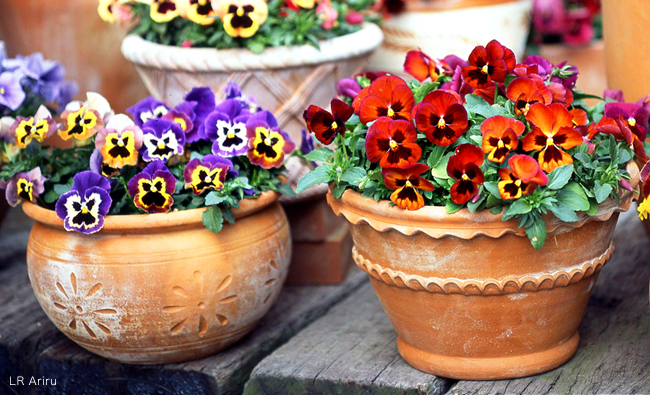- Top>
- Episode 06 Pansy

Episode 06 Pansy
LR(Long Run) pansy which can be enjoyed from autumn to spring
Viola tricolor has been commonly known as "heartsease" for a long time. It was originally taken from hillsides and fields where it grew naturally and was planted by enthusiasts in their gardens.
What we commonly know as the pansy is actually the product of human technical skill, i.e., breeding techniques. The beginning of this can be traced to 1813 when Lord Gambier's gardener, Thompson, started the pansy breeding process. He obtained hybrids through individuals of natural crossing of wild species such as V. tricolor, V. lutea, and V. Altaica. Thompson found the individual that had blotches of color on the petals and named it "Medora," which was later chosen for breeding purposes.
Thereafter, with the birth of the Pansy Society in Great Britain, the pansy was increasingly seen in exhibitions. In addition, being an inexpensive and a relatively robust plant, it was soon available throughout Europe, where it was the subject of further breeding experimentation. The garden variety, "Swiss Giant," the popularity of which has not waned to date, was developed in the 1920s by Logly of Switerland.

Swiss Giant

F1 Majestic Giant

Maxim
In 1966, Sakata ushered in a new era with the pansy F1 hybrid, a prize winner at the 1966 All-America Selections. Until the advent of extra large flower size varieties such as the "F1 Majestic Giant," which features flowers over 10 cm in diameter, only open pollinated varieties of pansies had been available, and there were no robust and high producting varieties. The new hybrid received high praise, and supply could not catch up with demand. Thereafter, mass production of the seeds commenced, and this heralded the establishment of F1 hybrid pansies in the market.
The F1 hybrid pansy varieties attracted a lot of attention at the Japan World Exposition (EXPO'70) in 1970 in Osaka, and its exhibition in earnest by the horticultural industry at the International Garden and Greenery Exposition (EXPO'90) in 1990 was a turning point.
As the demand for flower beds increases, Sakata continues breeding varieties of pansies such as the "Twentieth," "Maxim," and "Crystal" series.
The pansy F1 hybrids developed by Sakata exhibits vigorous and early growth characteristics. Because their seeds are sown in summer and start blooming in fall, the market in Japan has shifted from one for spring pansies to one for fall pansies, and this has been conducive to significant changes in demand and production.
After that the "Regal" variety was introduced, and it has become the leader in the fall pansy market.

Regal

LR Otono

LR Ariru
Pansies are originally spring bloomers, but with their long day flowering characteristics, seeds planted in summer, bloom in fall and sales are also mostly in fall. The problem is of flowers not being made to bloom in winter due to the season's short days.
Therefore, Sakata staff started thinking of a strategy to combat this issue. By modifying the physiological / ecological properties of the plant, could it be made to bloom in winter as well? So we then developed a plant that could bloom regardless of the length of the day.
Day length neutral and medium flower size varieties, such as the "LR Otono" series and the "LR Pronto" series were introduced in 1998, effectively solving the problem. The year 2000 saw the development of large flower size varieties such as the "LR Ariru" series, from which today's Sakata pansy claims its heritage.

Niji-iro-sumire ("Rainbow-colored violets")

Yokusaku-sumire ("Super-blooming violets")

E-ni-naru-sumire ("Pretty as a picture")
With robust international sales, the pansy could be considered the world's best loved plant. Not only is it resilient and resistant to cold but also its beauty is hard to resist. Niji-iro-sumire ("Rainbow-colored violets"), Yokusaku-sumire ("Super-blooming violets"), and E-ni-naru-sumire ("Pretty as a picture") varieties have also been introduced.
As long as people remain interested in pansies, there is no limit for their development. The world may be changing drastically around us, but heartsease will continue to make us happy for many years to come.




